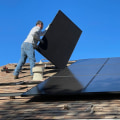Switching to renewable energy has become an increasingly popular topic in recent years, and for good reason. Not only does it have a positive impact on the environment, but it can also lead to significant financial savings for individuals and businesses alike. In this article, we will dive into the process of calculating potential savings from making the switch to renewable energy. Whether you are considering installing solar panels on your home or transitioning your company to run on clean energy sources, understanding the potential savings is crucial in making an informed decision.
So let's explore the financial benefits of renewable energy and how you can accurately calculate the potential savings for your specific situation. As the world becomes increasingly aware of the negative effects of traditional fossil fuels on the environment, more and more individuals and businesses are turning to renewable energy as a sustainable alternative. One such form of renewable energy is solar energy, which has gained popularity in recent years due to its numerous benefits and cost-effectiveness. In this article, we will explore the potential financial savings that can be achieved by switching to renewable energy, specifically through solar panel installation.Solar panel installation is a process where photovoltaic (PV) panels are installed on rooftops or other areas with access to sunlight. These panels absorb sunlight and convert it into usable electricity, which can then power homes and businesses.
This not only reduces reliance on traditional sources of energy, but also significantly decreases carbon emissions. One of the main benefits of solar panel installation is its cost-effectiveness. While the initial investment may seem high, the long-term savings far outweigh the upfront cost. This is because solar energy is essentially free once the panels are installed, as opposed to traditional energy sources that require ongoing payments for fuel and maintenance. For residential properties, switching to solar energy can save homeowners thousands of dollars each year on their energy bills. This is especially true for those living in areas with high electricity rates and plenty of sunlight.
In fact, studies have shown that homeowners who switch to solar energy can save an average of $20,000 over a 20-year period. Similarly, commercial properties can also benefit greatly from solar panel installation. By reducing their reliance on traditional energy sources, businesses can significantly decrease their operating costs and increase their bottom line. Additionally, many consumers are becoming increasingly environmentally conscious and are more likely to support businesses that prioritize sustainability. Now let's delve into how potential savings from switching to solar energy are calculated. The amount of money saved depends on various factors such as location, energy consumption, and government incentives.
Generally, the more sunlight a location receives and the higher the cost of traditional energy, the greater the potential savings from solar energy. Furthermore, government incentives such as tax credits and rebates can greatly reduce the cost of solar panel installation and increase potential savings. These incentives vary by state and country, so it's important to research and take advantage of them when considering switching to solar energy. It's also worth addressing some possible objections or misconceptions about the financial feasibility of renewable energy. One common misconception is that solar panel installation is only affordable for those with high incomes. However, with the decreasing cost of solar technology and various financing options available, solar energy is becoming increasingly accessible for all income levels. In conclusion, the potential financial savings from switching to renewable energy, specifically through solar panel installation, are significant and cannot be ignored.
Not only does it decrease reliance on traditional fossil fuels and reduce carbon emissions, but it also offers long-term cost-effectiveness for both residential and commercial properties. With government incentives and increasing accessibility, there has never been a better time to make the switch to renewable energy. Let's take a step towards a greener and more sustainable future.
Renewable Energy: A Sustainable Solution
As the world continues to face the consequences of climate change, more and more people are turning to renewable energy as a sustainable solution. Renewable energy sources, such as solar, wind, and hydropower, are natural sources that can be replenished and do not emit harmful greenhouse gases.This makes them a much more environmentally friendly option compared to traditional fossil fuels. But why does this matter? The answer lies in the fact that traditional fossil fuels are finite resources, meaning they will eventually run out. As we continue to rely on them for our energy needs, we not only contribute to the depletion of these resources but also contribute to the increasing levels of greenhouse gases in the atmosphere. Renewable energy, on the other hand, is a never-ending source of energy that will never run out. This makes it a sustainable solution that can help reduce our reliance on finite resources and mitigate the effects of climate change.
Solar Panel Installation: The Benefits
Solar panel installation is becoming a popular choice for individuals and businesses looking to switch to renewable energy. Not only does it help reduce carbon footprint, but it also offers significant financial benefits.In this section, we will explore how solar panels work and why they are worth the investment. Solar panels work by converting sunlight into electricity through the use of photovoltaic cells. These cells are made up of silicon, which is a semiconductor material that absorbs sunlight and generates an electric current. The initial cost of installing solar panels may seem daunting, but the long-term benefits outweigh the upfront investment. By generating your own electricity, you can significantly reduce your monthly utility bills. In fact, studies have shown that homeowners can save an average of $1,000 per year by switching to solar energy. In addition to saving money on utility bills, solar panels can also increase the value of your property.
A study by the National Renewable Energy Laboratory found that homes with solar panels sold for 17% more on average than homes without them. Furthermore, solar panels require minimal maintenance and have a lifespan of over 20 years. This means that once you make the initial investment, you can enjoy free electricity for many years to come. Overall, the benefits of solar panel installation are clear. Not only do they help reduce carbon emissions and protect the environment, but they also offer significant financial savings. So if you're considering switching to renewable energy, investing in solar panels is definitely worth it.
Calculating Potential Savings
When considering switching to renewable energy, one of the main factors that people want to know is how much money they can save.This is especially true for those interested in solar panel installation, as it is one of the most popular forms of renewable energy. So, what are the important factors to consider when estimating your potential savings from switching to solar energy?1.Cost of installationThe first factor to consider is the initial cost of installation. While the price of solar panels has decreased over the years, it still requires a significant upfront investment. However, many governments and utilities offer incentives and rebates to help offset this cost, making it more affordable for individuals and businesses.
2.Energy usage
The amount of energy you use plays a big role in determining your potential savings. If you have high energy usage, you will see a bigger decrease in your utility bills after switching to solar.It's important to take a look at your past energy bills to get an accurate estimate.
3.Location
The location of your solar panels also affects your potential savings. Areas with more sunlight will see a greater return on investment compared to areas with less sunlight.4.Maintenance and repairs
Solar panels require minimal maintenance, but it's important to factor in any potential repair costs into your savings estimate.5.Increase in property value
Another factor to consider is the potential increase in property value. Many studies have shown that homes with solar panels installed have a higher resale value, adding another aspect of financial benefit. By taking these factors into consideration, you can get a better estimate of the potential savings you can achieve by switching to solar energy. Keep in mind that every situation is unique and results may vary, but making the switch to renewable energy can lead to significant financial benefits in the long run.Addressing Objections
One of the main concerns surrounding the switch to renewable energy is the belief that it is not financially feasible.However, this is often due to common misconceptions and lack of understanding about the potential savings. Let's address some of the most common objections:High Upfront Costs: It is true that installing solar panels can have a high upfront cost. However, when looking at the long-term savings, it is important to consider the return on investment (ROI). In most cases, the initial investment can be recouped within 5-10 years, and the savings continue for decades after that.
Additionally, there are various financing options available that can help make the upfront costs more manageable.
Inconsistent Energy Production:
Another concern is the belief that renewable energy sources, such as solar panels, cannot consistently produce enough energy to meet a household or business' needs. However, with advancements in technology and battery storage options, this concern is becoming less and less relevant. Solar panels can now store excess energy for use during times of low production, ensuring a consistent and reliable source of energy.Lack of Government Incentives:
Some may argue that without government subsidies and incentives, renewable energy is not financially viable. While these incentives do play a role in making renewable energy more affordable, they are not necessary for achieving financial savings.The cost of renewable energy technology has significantly decreased in recent years, making it more accessible and cost-effective.
Inaccurate Cost Comparisons:
When comparing the cost of traditional energy sources to renewable energy, it is important to consider all factors. For example, traditional energy sources may have lower upfront costs, but they also have hidden costs such as environmental damage and health hazards. Renewable energy, on the other hand, has minimal impact on the environment and does not pose any health risks. By addressing these common objections and misconceptions, it is clear that switching to renewable energy can result in significant financial savings. As technology continues to advance and costs decrease, it is becoming an increasingly attractive and feasible option for individuals and businesses alike. Switching to renewable energy, specifically through solar panel installation, is not only a sustainable choice, but also a financially savvy one.By carefully considering factors such as location, energy consumption, and incentives, individuals and businesses can potentially save thousands of dollars in the long run. Not only that, but by investing in renewable energy, we are also investing in a cleaner and more sustainable future for generations to come.


